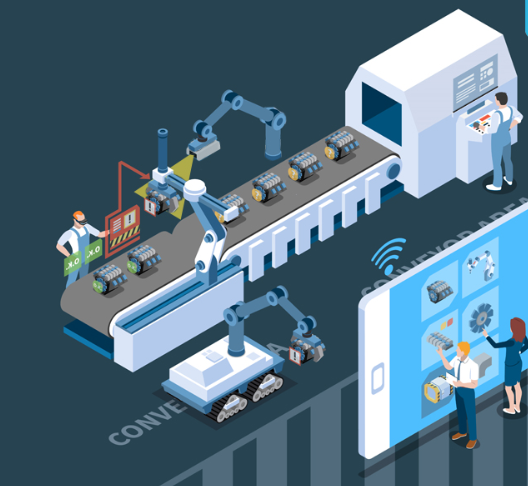
In today's rapidly evolving landscape, the influence of automation resonates across industries, revolutionizing processes and augmenting productivity. This paradigm shift, however, is not without challenges. Job displacement, quality control, adaptability, costs, and security concerns persist. The integration of computer vision, a facet of artificial intelligence, emerges as a beacon of solutions. By interpreting and comprehending visual data, computer vision addresses these hurdles, facilitating collaborative human-technology endeavors. This article explores the transformative synergy between automation and computer vision, reshaping industries for a more efficient and secure future.
The Impact of Automation:
Automation involves the use of technology to perform tasks with minimal human intervention. This paradigm shift has led to increased productivity, reduced errors, and enhanced precision. Routine and repetitive tasks can now be handled by machines, freeing up human resources to focus on higher-value activities that require creativity and critical thinking. Industries like manufacturing, logistics, and customer service have experienced substantial improvements in efficiency and cost-effectiveness.
Five Problems of Automation:
1. Unemployment Concerns: The fear of job displacement due to automation is a significant concern. As machines take over repetitive tasks, there's a risk of human workers losing their jobs.
2. Quality Control: Maintaining consistent quality during automated processes can be challenging. Machines might not identify subtle defects that a human eye could catch.
3. Adaptability: Not all processes can be easily automated, especially in industries that require complex decision-making or creativity.
4. Initial Costs: Implementing automation systems comes with high initial investments in technology, training, and infrastructure.
5. Security and Privacy: Automation involves the use of sensitive data, raising concerns about cybersecurity and privacy breaches.
Solving Challenges with Computer Vision:
Computer vision, a subset of artificial intelligence, enables machines to interpret and understand visual information from the world around them. It addresses several of the aforementioned challenges in automation:
1. Job Displacement: While automation can replace some tasks, computer vision can aid in creating new roles centered around maintaining, improving, and supervising automated systems.
5 simple steps to address job displacement ;
- Reskilling: Implement training in computer vision-related skills for the workforce.
- Collaborative Workflows: Combine human expertise with computer vision systems.
- Maintenance Roles: Assign workers to oversee and optimize technology performance.
- Quality Assurance:Use computer vision for meticulous product inspection.
- Enhanced Customer Service:Apply computer vision in customer interactions, offering personalized experiences.
2. Quality Control: Computer vision systems can meticulously analyze products for defects, ensuring higher accuracy and minimizing the chances of faulty items reaching consumers.
Here are five straightforward steps outlining how computer vision assists in quality control:
- Image Capture:Computer vision captures product images.
- Pattern Recognition:It identifies patterns and defects.
- Comparison Analysis: Computer vision compares images to standards.
- Defect Detection: It flags any deviations or defects.
- Real-time Feedback:Computer vision offers instant quality assessment.
3. Adaptability: Advanced computer vision algorithms can handle complex tasks like pattern recognition, allowing automation to extend to industries requiring intricate decision-making.
Here are five simple steps illustrating how computer vision aids in adaptability:
- Data Collection: Computer vision gathers visual data.
- Pattern Learning:It learns from patterns and variations.
- Decision Mapping:Computer vision maps decisions based on data.
- Algorithm Adjustment: It adapts algorithms for changing scenarios.
- Flexible Responses: Computer vision provides real-time, context-aware responses.
4. Cost Efficiency: While the initial investment might be substantial, computer vision can streamline operations, reducing long-term operational costs and errors.
Certainly, here are five straightforward steps outlining how computer vision contributes to cost efficiency:
- Automated Analysis: Computer vision analyzes data without human intervention.
- Resource Optimization: It optimizes resource allocation based on real-time data.
- Error Reduction: Computer vision minimizes costly errors and rework.
- Predictive Maintenance: It anticipates equipment issues, reducing downtime.
- Labor Savings: Computer vision reduces labor costs by streamlining tasks.
5. Security and Privacy: Computer vision-powered security systems enhance surveillance, authentication, and data protection, mitigating risks associated with automation.
Here are five simple steps highlighting how computer vision enhances security and privacy in automation:
- Real-time Surveillance:Computer vision monitors premises for unauthorized activities.
- Intrusion Detection: It promptly alerts potential breaches or threats.
- Access Control:Computer vision ensures authorized personnel access only.
- Anonymization Techniques: It masks personal data in visual information.
- Data Encryption:Computer vision secures captured data through encryption methods.
In conclusion, the impact of automation is undeniable, transforming industries and reshaping the workforce. While challenges like job displacement and quality control persist, the integration of computer vision technology offers viable solutions. Computer vision not only enhances the capabilities of automated systems but also addresses concerns related to adaptability, costs, security, and privacy. As industries continue to embrace automation and innovative technologies, the collaboration between automation and computer vision holds the key to a more efficient, productive, and secure future.
Embark on a journey of limitless possibilities by exploring our website, https://navan.ai/. Uncover a world of transformative progress and innovative breakthroughs that await you. At https://navan.ai/, delve into the realm of cutting-edge technology poised to accompany you on your next adventure.
Here's a glimpse of what you can find with Navan.ai:
1. Effortless Vision AI Model Development: Revolutionize development speed with the ability to build and deploy Vision AI models in mere minutes.
2. Simplified Cloud Deployment: With just one click, deploy AI models on the cloud and generate APIs in less than a minute.
3. No Coding Required: Embrace the future of technology without the burden of coding complexities. Focus on unleashing the potential of AI without the need for extensive coding.
For inquiries and a complimentary consultation, connect with us at https://navan.ai/contact-us. Our experts will guide you through the landscape of advanced technologies, offering insights and assistance.
Experience the convenience and power that Navan.ai brings, as it redefines your interaction with AI and technology. Your path to seamless innovation commences right now.